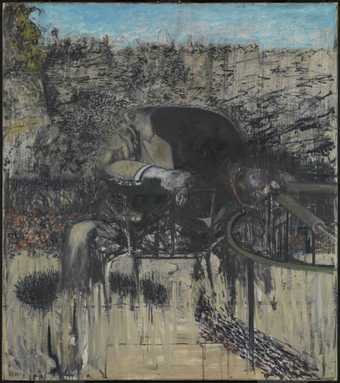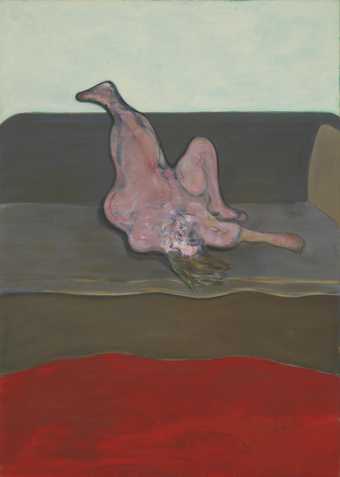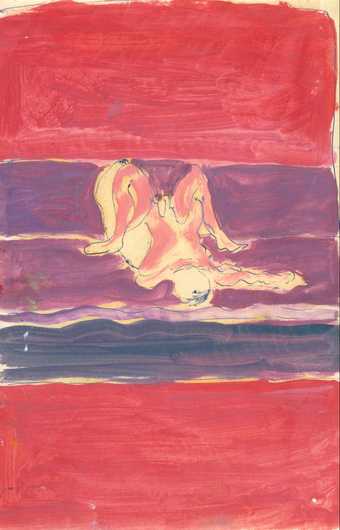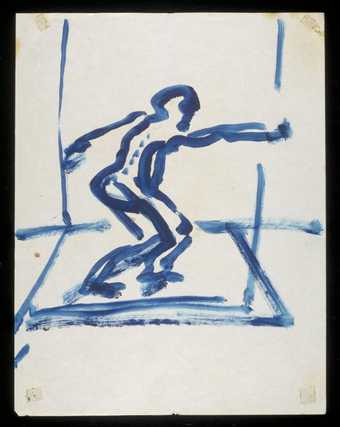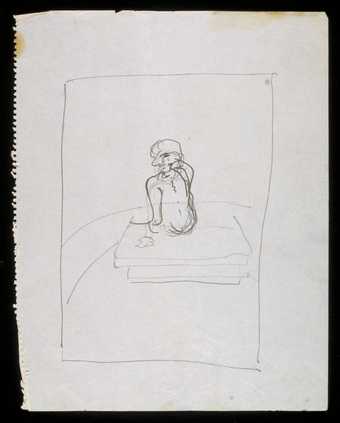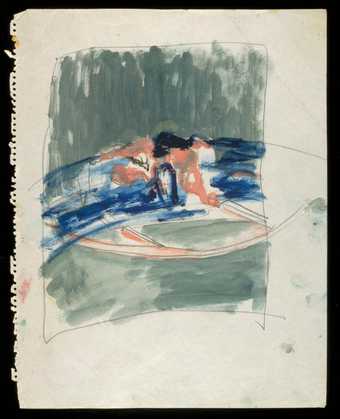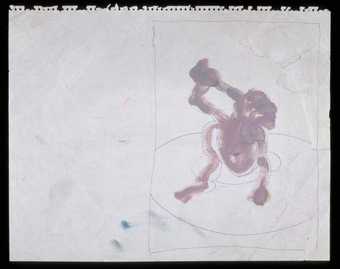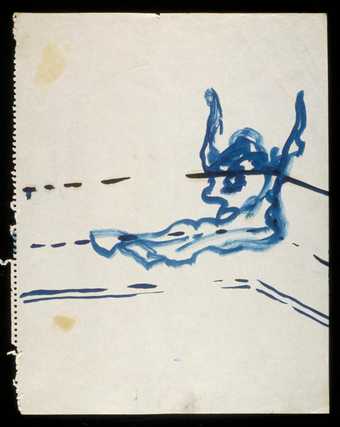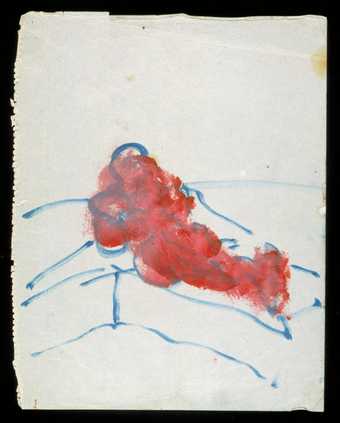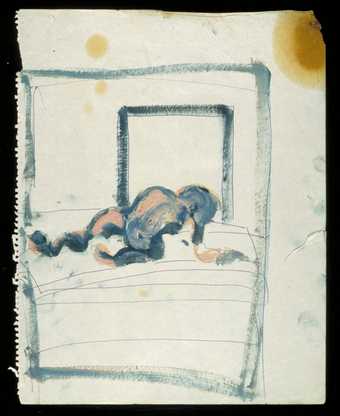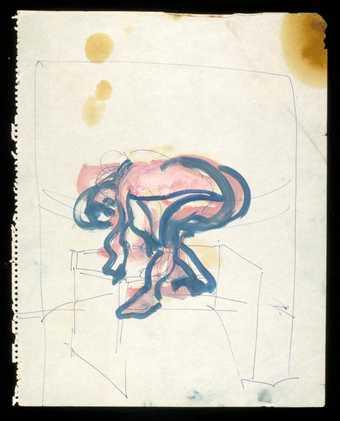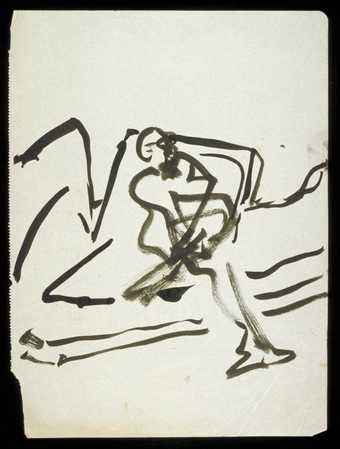
In Tate St Ives
- Artist
- Francis Bacon 1909–1992
- Medium
- Oil paint and ink on paper
- Dimensions
- Support: 222 × 150 mm
- Collection
- Tate
- Acquisition
- Purchased with assistance from the National Lottery through the Heritage Lottery Fund, the Art Fund and a group of anonymous donors in memory of Mario Tazzoli 1998
- Reference
- T07354
Display caption
This sketch may have served as colour studies and even responded to Mark Rothko's contemporary work (seen in London in 1959). The male nude and horizontal bands (derived from a sofa against a wall) are common to a series of Bacon's oil paintings from 1959 and 1961. The sketches appear to be later, as an impression of writing from another sheet but visible on 'Sketch [Reclining Figure, no.1]' gives his address as '7 Reece Mews', the studio which he occupied in the autumn of 1961.
Gallery label, March 2023
Does this text contain inaccurate information or language that you feel we should improve or change? We would like to hear from you.
Catalogue entry
Gouache and ballpoint pen on paper
235 x 154 (9 1/4 x 6 1/16)
Purchased from Matthew Spender with assistance from the National Lottery through the Heritage Lottery Fund, the National Art Collections Fund and a group of anonymous donors in memory of Mario Tazzoli, 1998
Provenance:
Given by the artist to Stephen Spender (early 1960s), from whom acquired by his son Matthew Spender (1967)
Exhibited:
Francis Bacon, Musée National d’Art Moderne, Centre Georges Pompidou, Paris, June-Oct.1996, Haus der Kunst, Munich, Nov.1996 - Jan.1997 (95, repr. in col. p.236 as ‘c.1963’)
Francis Bacon: Working on Paper, Tate Gallery, London, Feb.-April 1999 (4, repr. in col.)
Literature:
Fabrice Hergott and Hervé Vanel in Francis Bacon, exh. cat., Musée National d’Art Moderne, Centre Georges Pompidou, Paris 1996, p.235 (as Reclining Figure)
Richard Morphet, ‘Francis Bacon: 38 Unique Works on Paper; Four Unique Works on Paper’, National Art Collection Fund 1997 Review, London 1998, pp.99-100, repr. p.99
Matthew Gale, ‘Points of Departure’, in Francis Bacon: Working on Paper, exh. cat., Tate Gallery, London 1999, pp.13, 15, 31-2
Like Sketch [Reclining Figure, No. 1] (Tate Gallery T07353), this gouache appears to be a preparatory study for related oil paintings. Bacon sought to keep this stage of his work secret and denied making sketches. Nevertheless, in the early 1960s he gave the writer Stephen Spender both Sketch [Reclining Figure, No. 1] and Sketch [Reclining Figure, No. 2], as well as Sketch [Figure in a Landscape] (T07351) and Sketch [Turning Figure] (T07352). In 1962, around the time he was painting these gouaches, Bacon told Sylvester that sketches were ‘not very helpful for my kind of painting. As the actual texture, colour, the whole way the paint moves, are so accidental, any sketches that I did before could only give a kind of skeleton, possibly, of the way the thing might happen’. Since then the number of works on paper coming to light suggest that this was, in fact, a part of his working method.
The pose of the male nude in Sketch [Reclining Figure, No. 2] is exactly the same as that in its companion, and it consequently shares the same links to the three canvases of 1959 closely related to Reclining Woman, 1961 (Tate Gallery T00453). The gouaches have also been linked to Lying Figure with Hypodermic Syringe, 1963 (private collection), but there are sufficient differences in the detail of the pose and background to favour relating the dating of the gouaches to the earlier works. The impression of an address – ‘Reece Mews | SW7’ - which remains legible on Sketch [Reclining Figure, No. 1] places the pair of gouaches after Bacon moved to his South Kensington Studio in the autumn of 1961.
Both gouaches were painted on sheets of sketchbook paper over preliminary drawing in ballpoint pen. Where the hot colouring of the first suggests the charged sexual atmosphere, this second painting has a bluer hue and more subdued quality. The blue tones the pink of the body and dominates the plum and purple stripes which denote the background setting. The focal details are set slightly higher on the sheet and this tends to reinforce the impression that the two works served essentially as colour trials for larger compositions - exactly the ‘kind of skeleton ... of the way the thing might happen’ upon which the artist had remarked.
Matthew Gale
May 1998
Revised February 1999
Explore
- abstraction(8,615)
-
- non-representational(6,161)
-
- colour(2,481)
- domestic(1,795)
- furnishings(3,081)
-
- couch(203)
- male(959)
You might like
-
Francis Bacon Figure in a Landscape
1945 -
Francis Bacon Reclining Woman
1961 -
Francis Bacon Seated Figure
1961 -
Francis Bacon Sketch [Reclining Figure, No. 1]
c.1959–61 -
Francis Bacon Sketch [Figure with Arms Swung Out]
c.1959–61 -
Francis Bacon Sketch [Seated Figure]
c.1959–61 -
Francis Bacon Sketch [Figure in Grey Interior]
c.1959–61 -
Francis Bacon Sketch [Standing Figure]
c.1959–61 -
Francis Bacon Sketch [Figure with Foot in Hand]
c.1959–61 -
Francis Bacon Sketch [Fallen Figure]
c.1959–61 -
Francis Bacon Sketch [Fallen Figure with Arms Up]
c.1959–61 -
Francis Bacon Sketch [Figure Lying, No. 1]
c.1959–61 -
Francis Bacon Sketch [Pink Crawling Figure]
c.1959–61 -
Francis Bacon Sketch [Bending Figure, No. 2]
c.1959–61 -
Francis Bacon Sketch [Man on a Sofa]
c.1959–61

